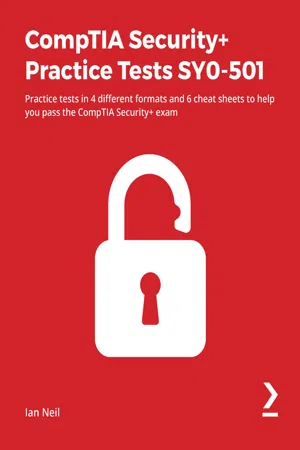
CompTIA Security+ Practice Tests SY0-501
Practice tests in 4 different formats and 6 cheat sheets to help you pass the CompTIA Security+ exam
- 252 pages
- English
- ePUB (mobile friendly)
- Available on iOS & Android
CompTIA Security+ Practice Tests SY0-501
Practice tests in 4 different formats and 6 cheat sheets to help you pass the CompTIA Security+ exam
About this book
Learn from Ian Neil, one of the world's top CompTIA Security+ trainers in the world, and enhance your analytical skills to pass the CompTIA Security+ SY0-501 exam
Key Features
- Become a pro at answering questions from all six of the domains of the SY0-501 exam
- Learn about cryptography algorithms, security policies, and their real-world implementations
- Solve practice tests that complement the official CompTIA Security+ certification exam
Book Description
CompTIA Security+ is a core security certification that will validate your baseline skills for a career in cybersecurity. Passing this exam will not only help you identify security incidents but will also equip you to resolve them efficiently. This book builds on the popular CompTIA Security+ Certification Guide, which mirrors the SY0-501 exam pattern.
This practice test-based guide covers all six domains of the Security+ SY0-501 exam: threats, attacks, and vulnerabilities; technologies and tools; architecture and design; identity and access management; cryptography and PKI; and risk management. You'll take six mock tests designed as per the official Security+ certification exam pattern, each covering significant aspects from an examination point of view. For each domain, the book provides a dedicated cheat sheet that includes important concepts covered in the test. You can even time your tests to simulate the actual exam. These tests will help you identify gaps in your knowledge and discover answers to tricky exam questions.
By the end of this book, you'll have developed and enhanced the skills necessary to pass the official CompTIA Security+ exam.
What you will learn
- Understand how prepared you are for the CompTIA Security+ certification
- Identify different types of security threats, attacks, and vulnerabilities
- Explore identity and access management in an enterprise environment
- Protect your business tools and platforms from cyberattacks
- Create and maintain a secure network
- Understand how you can protect your data
- Discover encryption techniques required to protect against various cyber threat scenarios
Who this book is for
If you are a security administrator, a system or network administrator, or anyone who wants to pass the CompTIA Security+ exam, this book is for you. This book is an ideal resource for students who want a career or degree in cybersecurity or are studying for the CISSP certification exam.
Frequently asked questions
- Essential is ideal for learners and professionals who enjoy exploring a wide range of subjects. Access the Essential Library with 800,000+ trusted titles and best-sellers across business, personal growth, and the humanities. Includes unlimited reading time and Standard Read Aloud voice.
- Complete: Perfect for advanced learners and researchers needing full, unrestricted access. Unlock 1.4M+ books across hundreds of subjects, including academic and specialized titles. The Complete Plan also includes advanced features like Premium Read Aloud and Research Assistant.
Please note we cannot support devices running on iOS 13 and Android 7 or earlier. Learn more about using the app.
Information
Chapter 1: Threats, Attacks, and Vulnerabilities Practice Tests
Practice Test 1 – Solution
Table of contents
- Title Page
- Copyright and Credits
- Dedication
- About Packt
- Contributors
- Preface
- Threats, Attacks, and Vulnerabilities Practice Tests
- Technologies and Tools Practice Tests
- Architecture and Design Practice Tests
- Identity and Access Management Practice Tests
- Cryptography and PKI Practice Tests
- Risk Management
- Assessment
- Other Books You May Enjoy